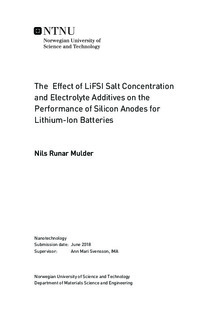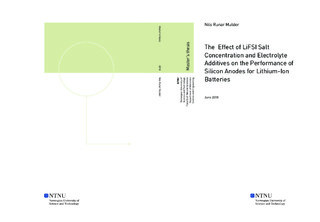| dc.description.abstract | Lithium-ion batteries (LIBs) are currently the dominant battery technology. However, the increasing technological demands in areas like energy storage, transportation and consumer electronics, require significant upgrades of the LIB with regard to energy density, power density, cost and safety. Commercial LIBs use a graphite anode, which despite having a long cycle life and low cost, is not energy dense, cheap or safe enough to meet future requirements. A part of the solution may be to utilize silicon as the anode material instead of graphite. Silicon has a ten times higher theoretical capacity, is cheaper and is considered safer. However, silicon struggles with large volumetric changes during lithiation and delithiation, leading to a thick solid electrolyte interface (SEI) layer and high irreversible capacity loss. In order to avoid these detrimental effects, different electrolyte compositions and additives can be used to try to tailor the SEI layer. In addition, additives can interact with the Li-salt, increasing the Li-conductivity and controlling Li-salt decomposition
In this project, the effect of electrolyte concentration on cell performance and SEI characteristics of Si anodes for LIBs has been investigated. The effect of various concentrations of the Li-salt lithium bis(fluorosulfonyl)imide (LiFSI) in 1:1 wt% ethylene carbonate:diethyl carbonate (EC:DEC) solvents on cell capacity was studied, resulting in an optimal concentration of 3 M. The positive effects of high salt concentration may be attributed to a reduction of the Li desolvation energy and possibly lower resistance in the SEI layer for concentrated electrolytes. The capacity obtained with 3 M LiFSI at a discharge rate of 1 C, was 1050 mAh/g after about 30 cycles, before it gradually dropped to 120 mAh/g after 200 cycles.
The additives fluoroethylene carbonate (FEC) and the anion receptor (AR) additive tris(hexafluoroisopropyl) borate (THFIPB) were combined (separately and together) with 3 M LiFSI to determine their effect on cell performance and SEI composition. An optimal electrolyte composition of 3 M LiFSI with 10 wt% FEC and 2 wt% THFIPB in EC:DEC was found, constantly yielding between 200-300 mAh/g higher capacity than only 3 M LiFSI throughout the entirety of the 200 cycles.
Post-mortem studies including Fourier Transform Infrared Spectroscopy (FTIR), X-ray Photoelectron Spectroscopy (XPS), Energy-Dispersive X-ray Spectroscopy (EDX), Focused Ion Beam (FIB) and Scanning Electron Micrscopy (SEM) were performed on the cycled anodes in order to investigate the SEI composition. The post-mortem investigations concluded that increasing the Li-salt concentration lead to a change in the SEI formation mechanism. At dilute salt concentration, the SEI formation was mainly dominated by EC-reduction, while it was dominated by Li-salt degradation at high salt concentrations. The latter mechanism lead to a less carbonaceous SEI, with more lithium fluoride (LiF) and LiFSI-degradation products. Furthermore, the post-mortem studies indicated that FEC promoted an even higher amount of LiF, while at the same time forming a protective initial SEI layer, leading to less salt decomposition and higher cell performance. It is suggested that THFIPB did not take part in SEI reactions, but rather coordinated to the FSI-anion, promoting Li-conductivity in the electrolyte.
Even though increased salt concentration leads to higher performing half cells, achieving a high capacity retention is still a challenging issue. It seems that an SEI dominated by inorganic components is not sufficiently stable. In future work, concentrated electrolytes should be combined with other additives, like vinylene carbonate (VC) and small amounts of lithium hexaluorophosphate LiPF6, in order to obtain high-performing, stable half cells that can work well in full-cell configurations too. | |

